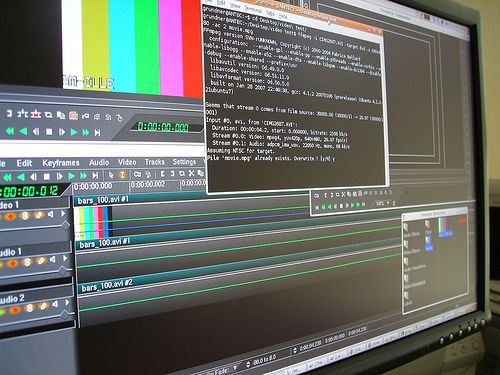
For this reason, we do not need to use other preprocessing tools. Note how, in this case, the object detector has its own data preprocessing component, which we can get with the get_cd_processor() function. Now that we have a detector object, we need to setup a function to use it. set_detection_threshold ( DETECTOR_SCORE_THRESHOLD ) object_detector. (Output).From metavision_ml.detection_tracking import ObjectDetector network_input_width = ev_width // NN_DOWNSCALE_FACTOR network_input_height = ev_height // NN_DOWNSCALE_FACTOR object_detector = ObjectDetector ( NN_MODEL_DIRECTORY, events_input_width = ev_width, events_input_height = ev_height, runtime = DEVICE, network_input_width = network_input_width, network_input_height = network_input_height ) object_detector. (Make sure you cannot see video preview, this means the Smart Rendering Codec is bitstreaming)ġ7. Double check the Smart Rendering Codec is enabledġ6. Rename your output file destination from "(Output)_temp_1.mxf" to "(Output).mxf"ġ5. (for this specific file in the tutorial) Change "Video Codec" in the Video tab from "XDCAMEX 35 NTSC 1080 (4:2:0)" to "XDCAMEX 35 NTSC 720 (4:2:0)"ġ4. Change 16bit to 24bit (if you left -c:a pcm_s24le in the command for the audio splitting step)ġ3. Click into the preset, change your audio channels to the amount you know are presentġ2. (for this specific file in the tutorial) Browse your XDCAM HD presets and find "XDCAM EX 35 NTSC 60i" and drag it into your queue onto "(Output)_temp.mxf" as a starting pointġ1. Take (Output)_temp.mxf, import into Adobe Media Encoder CCġ0. (for this specific file in the tutorial) Type "ffmpeg -i "(Input file).mov" -i "(Output)_L.wav" -i "(Output)_R.wav" -map 0:0 -map 1:0 -map 2:0 -r 59.94 -c:v copy -c:a copy "(Output)_temp.mxf"ĩ. (for this specific file in the tutorial) Type ffmpeg -i "(Input file)" -vn -c:a pcm_s24le -filter_complex "pan=1c|c0=c0 pan=1c|c0=c1" -map "" "(Output)_L.wav" -vn -c:a pcm_s24le -map "" "(Output)_R.wav" (You can remove -c:a pcm_s24le to do a native split, but keep in mind the limitations of MXF audio muxing)Ĩ. While -c:a copy will work, MPEG-2 MXFs only like multiple mono audio streams to ensure maximum compatibility.ħ. Stream 0:1 is a stereo audio stream in this case. Determine how many audio channels and streams are present, and if the format can't be copied using -c:a copy. Shift + Right Click and "Open Command Window Here"Ħ. Put FFmpeg in the same folder as your work folder for rewrappingĤ. (Thank you to TWiT Know How, Iyaz Akhtar, Alex Lindsay and Fr.
#Ffmpeg tutorial 3.0.2 download#
Get the freely available sample file from /details/GreenScreenForYout and Download the "QUICKTIME" file. (Output).mxf is a fully compliant XDCAM MXF OP1a ready to edit with the original timecode data from the MOVġ. (Make sure you cannot see video preview, this means the Smart Rendering Codec is bitstreaming)ġ3. Double check the Smart Rendering Codec is enabledġ2. Rename your output file destination from "(Output)_temp_1.mxf" to "(Output).mxf"ġ1. Click into the preset, change your audio channels to the amount you know are presentġ0. (for this specific file in the tutorial) Browse your XDCAM HD presets and find "XDCAM HD 50 NTSC 60i" and drag it into your queue onto "(Output)_temp.mxf"ĩ. Take (Output)_temp.mxf, import into Adobe Media Encoder CCĨ. (for this specific file in the tutorial) Type "ffmpeg -i "(Input file).mov" -map 0:0 -map 0:1 -map 0:2 -map 0:3 -map 0:4 -map 0:5 -map 0:6 -map 0:7 -map 0:8 -r 29.97 -c:v copy -c:a pcm_s24le "(Output)_temp.mxf" (The video used different file names cause I was rushing through it, your actual procedures follow making (Output)_temp.mxf and changing to an (Output).mxf at the end in AME)ħ.

(32bit audio and Big Endian audio) Stream 0:0 is video and Streams 0:1 to 0:8 are audio in this specific caseĦ. Determine how many audio streams and channels are present, and if the format can't be copied using -c:a copy. (Output).mxf is a fully compliant DNxHD MXF OP1a ready to edit with the original timecode data from the MOVĥ. (Make sure you cannot see video preview, this means the Smart Rendering Codec is bitstreaming)ġ2. Double check the Smart Rendering Codec is enabledġ1. Rename your output file destination from "(Output)_temp_1.mxf" to "(Output).mxf"ġ0.

If it's only stereo, leave the default of stereoĩ. Click into the preset, change your audio channels to the amount you know are present. Browse your DNxHD MXF OP1a presets and find "Match Source (Rewrap)" and drag it into your queue onto "(Output)_temp.mxf"ħ. Take (Output)_temp.mxf, import into Adobe Media Encoder CCĦ. Type "ffmpeg -i "(Input file).mov" -r (Frame rate) -c:v copy -c:a copy (Output)_temp.mxfĥ. Shift + Right Click and "Open Command Window Here"Ĥ. Put FFmpeg in the same folder as your work folder for rewrappingģ.
#Ffmpeg tutorial 3.0.2 how to#
This tutorial shows how to rewrap DNxHD QT files to DNxHD MXF OP1a files on Windowsġ.


 0 kommentar(er)
0 kommentar(er)
